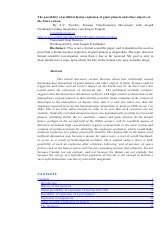Feb 9, 2009
Nanotech Development: You Can’t Please All of the People, All of the Time
Posted by Thomas M. Powers in categories: ethics, nanotechnology, policy
Abstract
What counts as rational development and commercialization of a new technology—especially something as potentially wonderful (and dangerous) as nanotechnology? A recent newsletter of the EU nanomaterials characterization group NanoCharM got me thinking about this question. Several authors in this newsletter advocated, by a variety of expressions, a rational course of action. And I’ve heard similar rhetoric from other camps in the several nanoscience and nanoengineering fields.
We need a sound way of characterizing nanomaterials, and then an account of their fate and transport, and their novel properties. We need to understand the bioactivity of nanoparticles, and their effect in the environments where they may end up. We need to know what kinds of nanoparticles occur naturally, which are incidental to other engineering processes, and which we can engineer de novo to solve the world’s problems—and to fill some portion of the world’s bank accounts. We need life-cycle analyses, and toxicity and exposure studies, and cost-benefit analyses. It’s just the rational way to proceed. Well who could argue with that?
Article
Continue reading “Nanotech Development: You Can't Please All of the People, All of the Time” »


 I wrote an essay on the theme of the possibility of artificial initiation and fusion explosion of giants planets and other objects of Solar system. It is not a scientific article, but an atempt to collect all nesessary information about this existential risk. I conclude that it could not be ruled out as technical possibility, and could be made later as act of space war, which could clean entire Solar system.
I wrote an essay on the theme of the possibility of artificial initiation and fusion explosion of giants planets and other objects of Solar system. It is not a scientific article, but an atempt to collect all nesessary information about this existential risk. I conclude that it could not be ruled out as technical possibility, and could be made later as act of space war, which could clean entire Solar system.







